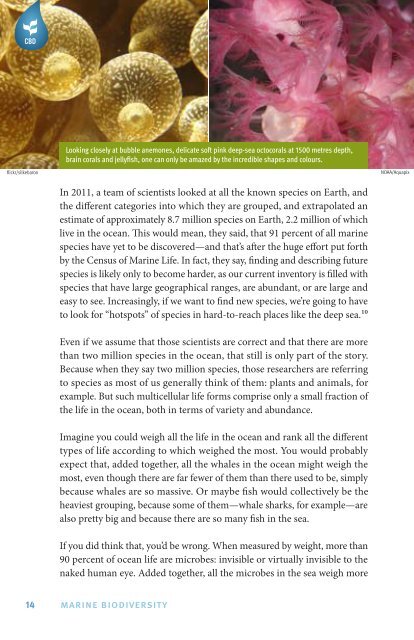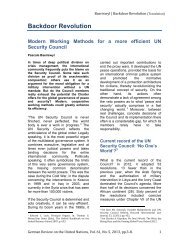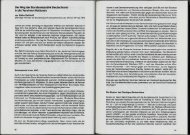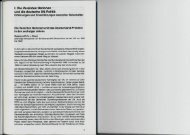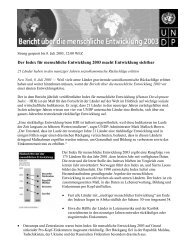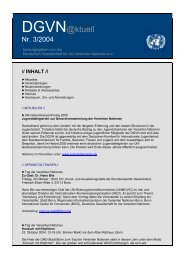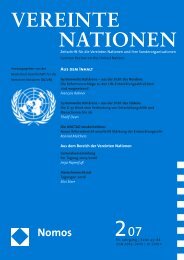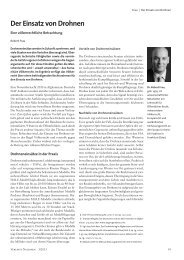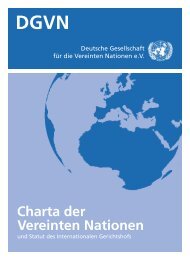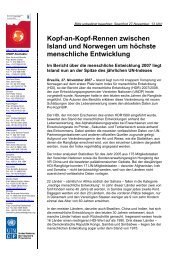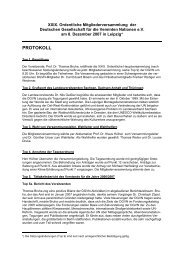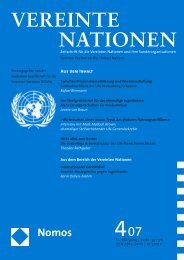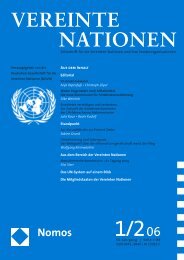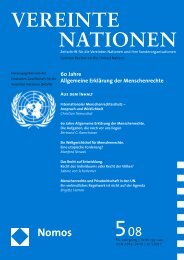One Ocean, Many Worlds of Life - Convention on Biological Diversity
One Ocean, Many Worlds of Life - Convention on Biological Diversity
One Ocean, Many Worlds of Life - Convention on Biological Diversity
Create successful ePaper yourself
Turn your PDF publications into a flip-book with our unique Google optimized e-Paper software.
Looking closely at bubble anem<strong>on</strong>es, delicate s<str<strong>on</strong>g>of</str<strong>on</strong>g>t pink deep-sea octocorals at 1500 metres depth,<br />
brain corals and jellyfish, <strong>on</strong>e can <strong>on</strong>ly be amazed by the incredible shapes and colours.<br />
flickr/silkebar<strong>on</strong> NOAA/Aquapix<br />
In 2011, a team <str<strong>on</strong>g>of</str<strong>on</strong>g> scientists looked at all the known species <strong>on</strong> Earth, and<br />
the different categories into which they are grouped, and extrapolated an<br />
estimate <str<strong>on</strong>g>of</str<strong>on</strong>g> approximately 8.7 milli<strong>on</strong> species <strong>on</strong> Earth, 2.2 milli<strong>on</strong> <str<strong>on</strong>g>of</str<strong>on</strong>g> which<br />
live in the ocean. This would mean, they said, that 91 percent <str<strong>on</strong>g>of</str<strong>on</strong>g> all marine<br />
species have yet to be discovered—and that’s after the huge effort put forth<br />
by the Census <str<strong>on</strong>g>of</str<strong>on</strong>g> Marine <str<strong>on</strong>g>Life</str<strong>on</strong>g>. In fact, they say, finding and describing future<br />
species is likely <strong>on</strong>ly to become harder, as our current inventory is filled with<br />
species that have large geographical ranges, are abundant, or are large and<br />
easy to see. Increasingly, if we want to find new species, we’re going to have<br />
to look for “hotspots” <str<strong>on</strong>g>of</str<strong>on</strong>g> species in hard-to-reach places like the deep sea.10<br />
Even if we assume that those scientists are correct and that there are more<br />
than two milli<strong>on</strong> species in the ocean, that still is <strong>on</strong>ly part <str<strong>on</strong>g>of</str<strong>on</strong>g> the story.<br />
Because when they say two milli<strong>on</strong> species, those researchers are referring<br />
to species as most <str<strong>on</strong>g>of</str<strong>on</strong>g> us generally think <str<strong>on</strong>g>of</str<strong>on</strong>g> them: plants and animals, for<br />
example. But such multicellular life forms comprise <strong>on</strong>ly a small fracti<strong>on</strong> <str<strong>on</strong>g>of</str<strong>on</strong>g><br />
the life in the ocean, both in terms <str<strong>on</strong>g>of</str<strong>on</strong>g> variety and abundance.<br />
Imagine you could weigh all the life in the ocean and rank all the different<br />
types <str<strong>on</strong>g>of</str<strong>on</strong>g> life according to which weighed the most. You would probably<br />
expect that, added together, all the whales in the ocean might weigh the<br />
most, even though there are far fewer <str<strong>on</strong>g>of</str<strong>on</strong>g> them than there used to be, simply<br />
because whales are so massive. Or maybe fish would collectively be the<br />
heaviest grouping, because some <str<strong>on</strong>g>of</str<strong>on</strong>g> them—whale sharks, for example—are<br />
also pretty big and because there are so many fish in the sea.<br />
If you did think that, you’d be wr<strong>on</strong>g. When measured by weight, more than<br />
90 percent <str<strong>on</strong>g>of</str<strong>on</strong>g> ocean life are microbes: invisible or virtually invisible to the<br />
naked human eye. Added together, all the microbes in the sea weigh more<br />
14 Marine BiOdiversity


